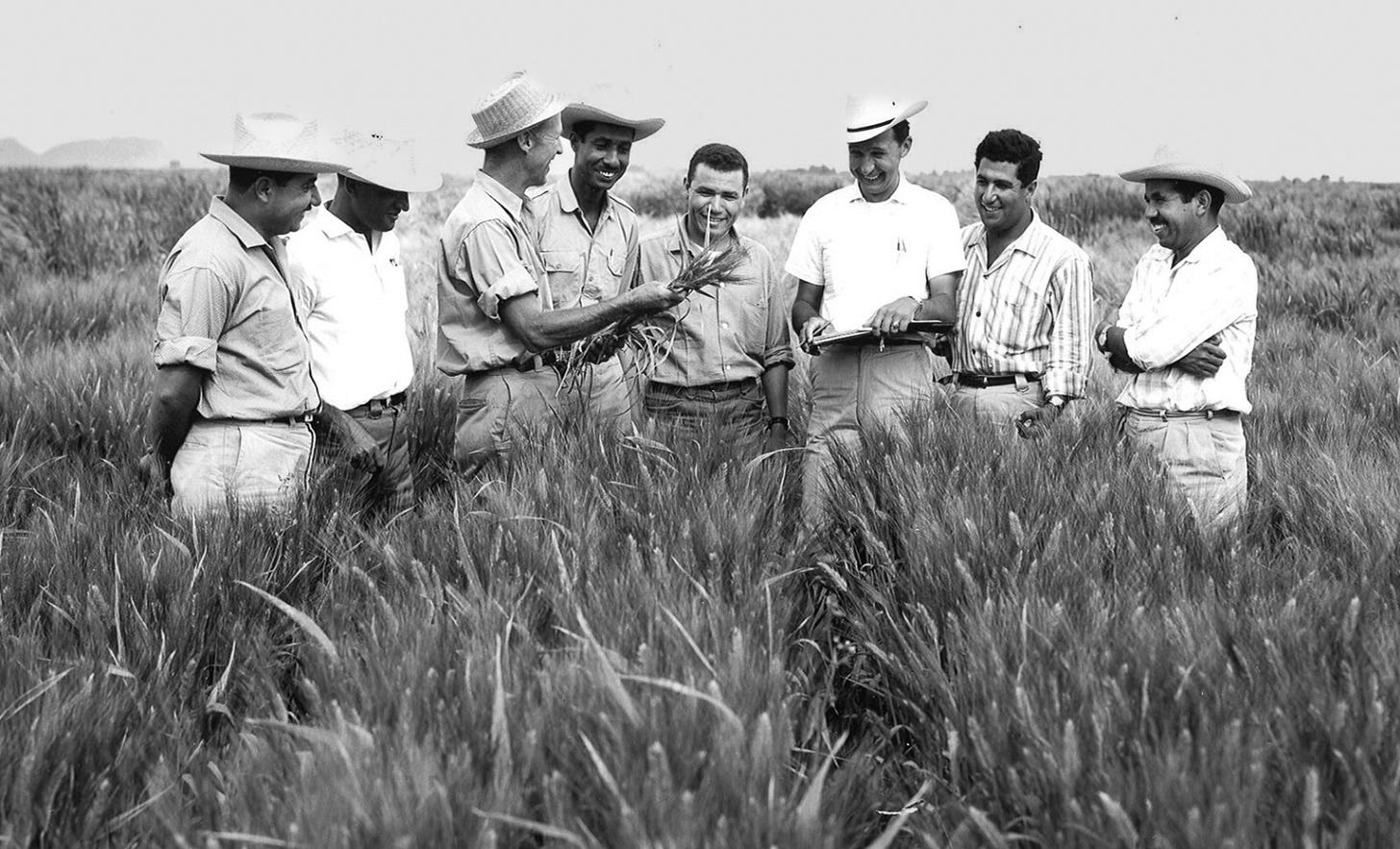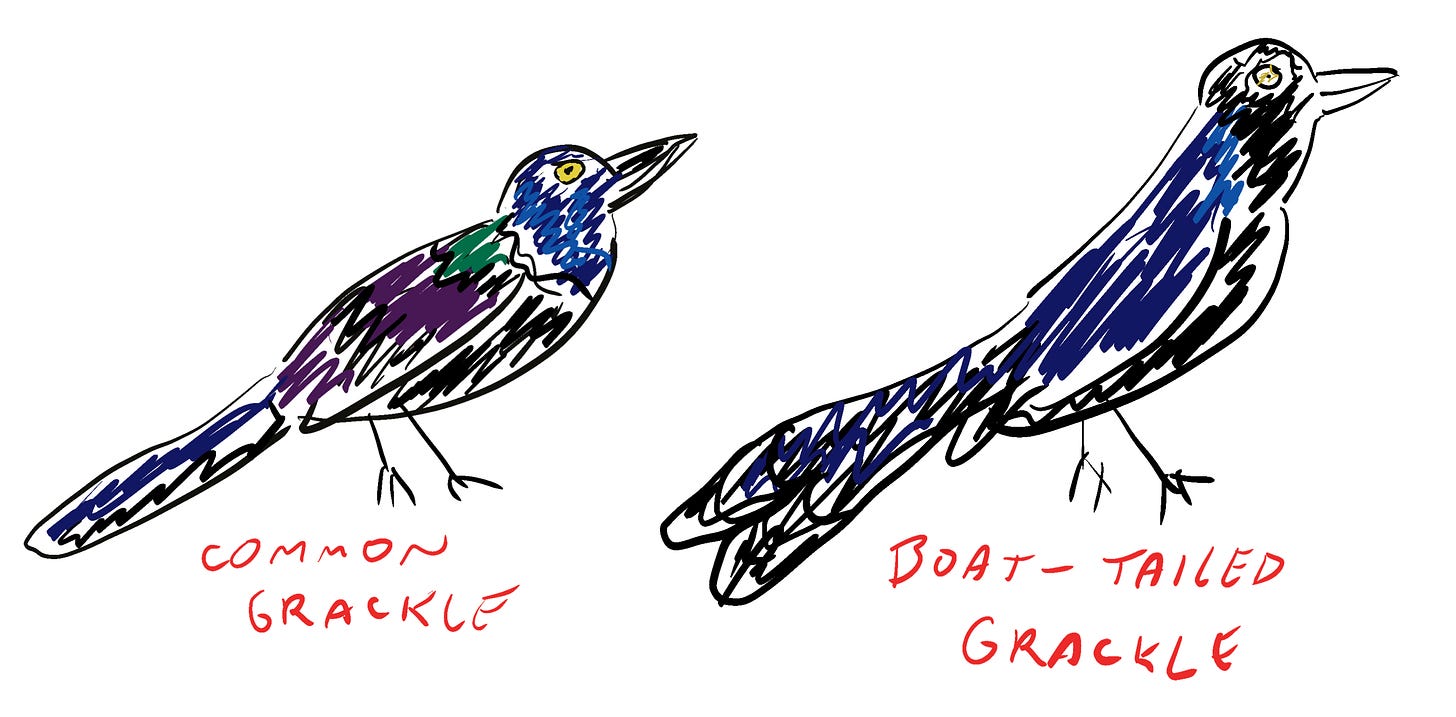Welcome back! Ahoy-hoy! Salutations! We're very happy to see you.
While browsing Anthropocene for the rare bit of uplifting news, your correspondent came across a group photo featuring sharply dressed, warm-smiling gentlemen. The companion article highlights how decades of agricultural innovations, pioneered by Norman Borlaug in the 1960s, boosted food security, saved land, and preserved biodiversity.
How did Borlaug et al do it? High-yield crops. When farms are more productive, less wild land gets cleared for agriculture. A recent study shows that this innovation has saved 16 million hectares of habitat, spared over 1000 species from extinction, and kept billions of tons of carbon safely tucked away in Gaia’s bosom.
I love me some uplifting news! But hold on…oh, wait. Shit. My gloss-over detector is beeping! Because as sweet as this all sounds, and as drippy as Borlaug looks doing it, human innovation always has a pricetag. Reckless high-yield farming, it turns out, can lead to overuse of fertilizers and pesticides, wreaking havoc on ecosystems and depleting soil.
To his credit, Borlaug took such negative externalities seriously. He said his work was a step in the right direction, but “it has not transformed the world into a Utopia.” He was clear: "There are no miracles in agricultural production."
Miracles, easy answers, blacks and whites. Gloss-over detector BEEEP! In 2025, when social media algorithms train us to gulp down outrage alongside instant fixes, it’s tempting to Pac-Man chomp for easy answers. But these “answers” are usually illusions—empty promises made by questionable folks with mixed motives.
Real understanding and lasting change don’t come in neat packages nor one-size-fits-all answers nor executive orders. They require confronting the mess, the gray areas and the complexities. Shallow solutions are for the weak, the simple, the naïve. Depth is pain, depth is evolution, depth is beauty.
So, instead of passively consuming, unwittingly seeking that next quick fix (of outrage or justice or happiness or doom or whatever), try deeply noticing the world. Not just societal issues, not just birds, but the moments and contexts and interactions that make up your real life. Notice the imperfections and the awe, side by side. Then, decide what you want to conserve and what you want to change.
In this way, you can reorder the world.

MICRO-SEASON: JAN 27 - FEB 16
Unlike the quarters of labor time made up by corporate humanoids, micro-seasons are straight from Source, the Great Unity, the god-babe herself: Mother Nature 🙇
This micro-season, in McGolrick Park, our urban forest proxy for New York City, and perhaps even larger swathes of the wild eastern US, one noticed:
First of season Common Grackles · Young squirrels leave nests
And this complete list of bird species:
Common Grackle · Dark-eyed Junco · White-throated Sparrow · Tufted Titmouse · White-breasted Nuthatch · Red-tailed Hawk · Cooper’s Hawk · Downy Woodpecker · Red-bellied Woodpecker · Northern Flicker · Yellow-bellied Sapsucker · Brown Creeper · Northern Cardinal · Blue Jay · American Kestrel · Fish Crow · American Crow · Common Raven · Plus the virtually always present in urban parks Rock Pigeon, European Starling, American Robin, House Sparrow and Mourning Dove
Common Grackles, until this micro-season, hadn’t chilled in McGolrick Park since heading south in early November. How do we know this? Noticing, memory and crowdsourced likelihood data via eBird
There are three grackle species findable in the US. Wanna know ‘em? Keep reading!
Squirrels have two breeding seasons: one in summer, one in winter. We witnessed larger than average groups of probably juvenile squirrels playing in New York City parks this micro-season
Read about the history of Eastern Grey Squirrels, including how they were reintroduced to NYC parks, here
Current Japanese micro-season: Ice thickens on streams & Hens start to lay eggs
MICRO-LESSON: GRACKLES (AND BLACKBIRDS)
Grackle numbers are right now increasing in New York City. There are only two eastern species to know: the Common and the Boat-tailed Grackles. They kinda look like small, skinny crows. They’re actually long-tailed blackbirds.

Common Grackles are often found walking around lawns and fields, or gathering in noisy flocks. They can be green-purple iridescent + glossy, cut flappy Jesus on cross profiles in flight, and have striking yellow eyes. Make sure to distinguish them from European Starlings, especially via tail length.
If you find yourself near the sea, look out for Boat-tailed Grackles. The glossy blue-black males are hard to miss, with their suuuper long, gown train tails. The females are smaller than the males, and rock pretty brown colors under black wings.

Curious about blackbirds, generally? In NYC’s bigger parks, we’ve got year-round Red-winged Blackbirds and Brown-headed Cowbirds. In summer, Baltimore and Orchard Orioles visit NYC and breed. (Yes, orioles are blackbirds!) Then, during spring and fall migrations, Rusty Blackbirds, Eastern Meadowlarks and Bobolinks pass through town.





